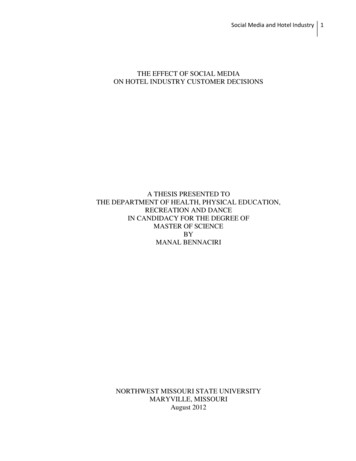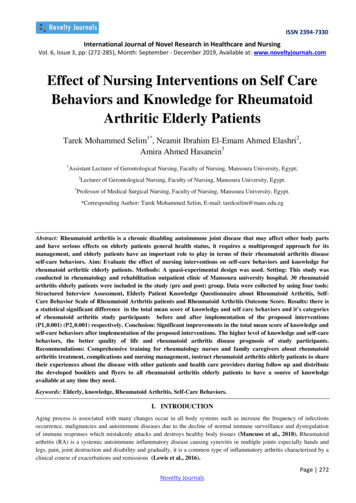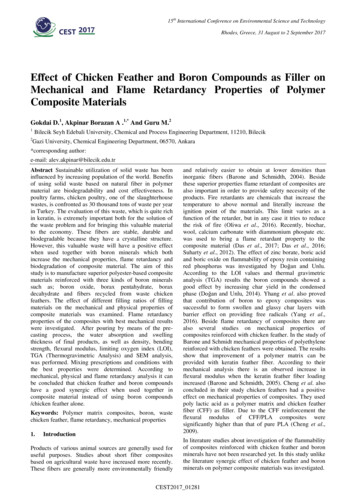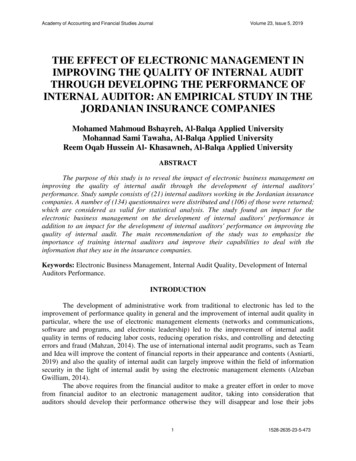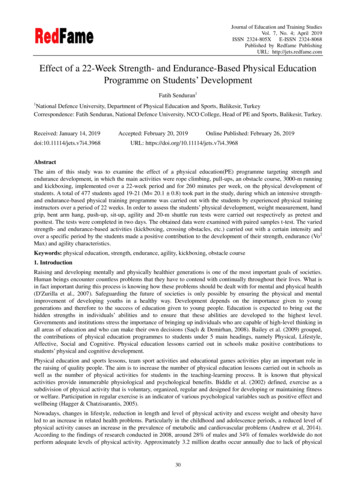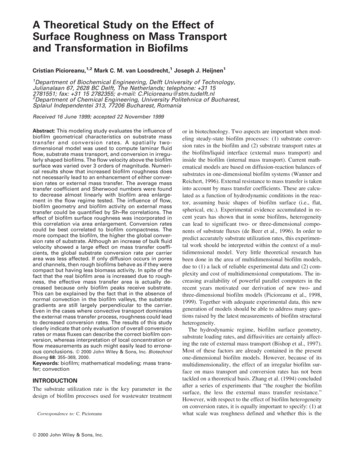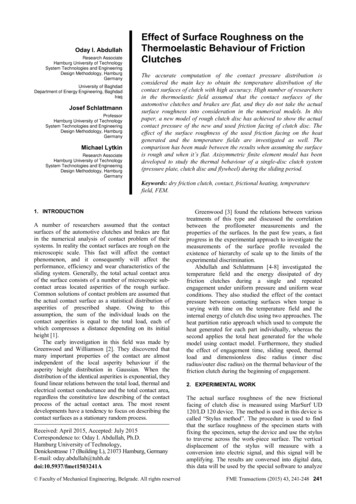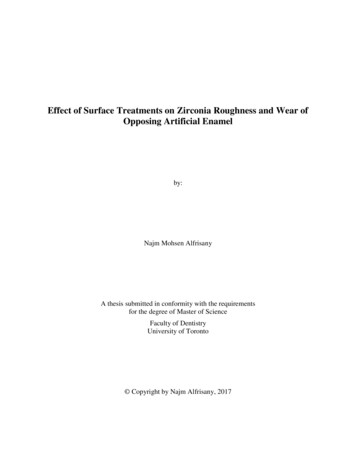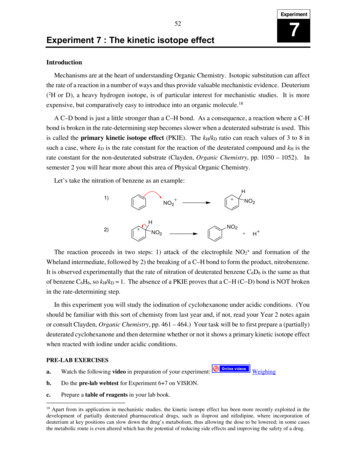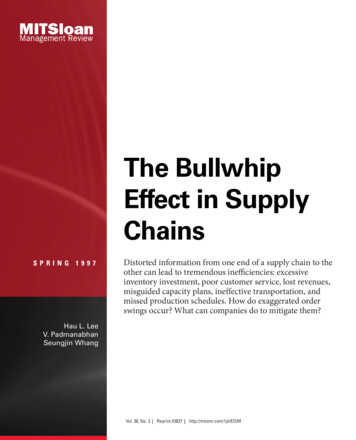
Transcription
The BullwhipEffect in SupplyChainsSPRING 1997Distorted information from one end of a supply chain to theother can lead to tremendous inefficiencies: excessiveinventory investment, poor customer service, lost revenues,misguided capacity plans, ineffective transportation, andmissed production schedules. How do exaggerated orderswings occur? What can companies do to mitigate them?Hau L. LeeV. PadmanabhanSeungjin WhangVol. 38, No. 3Reprint #3837http://mitsmr.com/1phEOiM
The Bullwhip Effect in SupplyChainsHau L. Lee V. Padmanabhan Seungjin WhangDistorted information from one endof a supply chain to the other canlead to tremendous inefficiencies:excessive inventory investment, poorcustomer service, lost revenues,misguided capacity plans, ineffectivetransportation, and missedproduction schedules. How doexaggerated order swings occur? Whatcan companies do to mitigate them?Not long ago, logistics executives at Procter &Gamble (P&G) examined the order patterns for one of their best-selling products,Pampers. Its sales at retail stores were fluctuating, butthe variabilities were certainly not excessive. However,as they examined the distributors’ orders, the executives were surprised by the degree of variability. Whenthey looked at P&G’s orders of materials to their suppliers, such as 3M, they discovered that the swingswere even greater. At first glance, the variabilities didnot make sense. While the consumers, in this case,the babies, consumed diapers at a steady rate, the demand order variabilities in the supply chain were amplified as they moved up the supply chain. P&Gcalled this phenomenon the “bullwhip” effect. (Insome industries, it is known as the “whiplash” or the“whipsaw” effect.)When Hewlett-Packard (HP) executives examinedthe sales of one of its printers at a major reseller, theyfound that there were, as expected, some fluctuationsSLOAN MANAGEMENT REVIEW/SPRING 1997over time. However, when they examined the ordersfrom the reseller, they observed much bigger swings.Also, to their surprise, they discovered that the ordersfrom the printer division to the company’s integratedcircuit division had even greater fluctuations.What happens when a supply chain is plagued witha bullwhip effect that distorts its demand informationas it is transmitted up the chain? In the past, withoutbeing able to see the sales of its products at the distribution channel stage, HP had to rely on the sales orders from the resellers to make product forecasts, plancapacity, control inventory, and schedule production.Big variations in demand were a major problem forHP’s management. The common symptoms of suchvariations could be excessive inventory, poor productforecasts, insufficient or excessive capacities, poor customer service due to unavailable products or long backlogs, uncertain production planning (i.e., excessive revisions), and high costs for corrections, such as for expedited shipments and overtime. HP’s product divisionwas a victim of order swings that were exaggerated bythe resellers relative to their sales; it, in turn, createdadditional exaggerations of order swings to suppliers.In the past few years, the Efficient Consumer Response (ECR) initiative has tried to redefine how thegrocery supply chain should work.1 One motivationfor the initiative was the excessive amount of inventory in the supply chain. Various industry studies foundthat the total supply chain, from when products leavethe manufacturers’ production lines to when they arrive on the retailers’ shelves, has more than 100 days ofHau L. Lee is the Kleiner Perkins, Mayfield, Sequoia Capital Professorin Industrial Engineering and Engineering Management, and professorof operations management at the Graduate School of Business, StanfordUniversity. V. Padmanabhan is an associate professor of marketing, andSeungjin Whang is an associate professor of operations information andtechnology, also at Stanford.LEE ET AL.93
Figure 1 Increasing Variability of Orders up the Supply ChainRetailer's Orders to Manufacturer20201515Order QuantityOrder QuantityConsumer Sales1050TimeWholesaler's Orders to ManufacturerManufacturer's Orders to Supplier20201515105Timeinventory supply. Distorted information has led everyentity in the supply chain — the plant warehouse, amanufacturer’s shuttle warehouse, a manufacturer’smarket warehouse, a distributor’s central warehouse,the distributor’s regional warehouses, and the retailstore’s storage space — to stockpile because of thehigh degree of demand uncertainties and variabili-The ordering patterns share acommon, recurring theme: thevariabilities of an upstreamsite are always greater than thoseof the downstream site.ties. It’s no wonder that the ECR reports estimated apotential 30 billion opportunity from streamliningthe inefficiencies of the grocery supply chain.2Other industries are in a similar position. Computerfactories and manufacturers’ distribution centers, theLEE ET AL.10500945TimeOrder QuantityOrder Quantity010Timedistributors’ warehouses, and store warehouses alongthe distribution channel have inventory stockpiles.And in the pharmaceutical industry, there are duplicated inventories in a supply chain of manufacturers suchas Eli Lilly or Bristol-Myers Squibb, distributors suchas McKesson, and retailers such as Longs Drug Stores.Again, information distortion can cause the total inventory in this supply chain to exceed 100 days of supply. With inventories of raw materials, such as integrated circuits and printed circuit boards in the computerindustry and antibodies and vial manufacturing in thepharmaceutical industry, the total chain may containmore than one year’s supply.In a supply chain for a typical consumer product,even when consumer sales do not seem to vary much,there is pronounced variability in the retailers’ ordersto the wholesalers (see Figure 1). Orders to the manufacturer and to the manufacturers’ supplier spike evenmore. To solve the problem of distorted information,companies need to first understand what creates thebullwhip effect so they can counteract it. Innovativecompanies in different industries have found that theySLOAN MANAGEMENT REVIEW/SPRING 1997
can control the bullwhip effect and improve their supply chain performance by coordinating informationand planning along the supply chain.Causes of the Bullwhip EffectPerhaps the best illustration of the bullwhip effect isthe well-known “beer game.”3 In the game, participants (students, managers, analysts, and so on) playthe roles of customers, retailers, wholesalers, and suppliers of a popular brand of beer. The participantscannot communicate with each other and must makeorder decisions based only on orders from the nextdownstream player. The ordering patterns share acommon, recurring theme: the variabilities of an upstream site are always greater than those of the downstream site, a simple, yet powerful illustration of thebullwhip effect. This amplified order variability maybe attributed to the players’ irrational decision making.Indeed, Sterman’s experiments showed that human behavior, such as misconceptions about inventory anddemand information, may cause the bullwhip effect.4In contrast, we show that the bullwhip effect is aconsequence of the players’ rational behavior withinthe supply chain’s infrastructure. This important distinction implies that companies wanting to control thebullwhip effect have to focus on modifying the chain’sinfrastructure and related processes rather than the decision makers’ behavior.We have identified four major causes of the bullwhip effect:1. Demand forecast updating2. Order batching3. Price fluctuation4. Rationing and shortage gamingEach of the four forces in concert with the chain’sinfrastructure and the order managers’ rational decision making create the bullwhip effect. Understandingthe causes helps managers design and develop strategies to counter it.5Demand Forecast UpdatingEvery company in a supply chain usually does productforecasting for its production scheduling, capacity planning, inventory control, and material requirementsplanning. Forecasting is often based on the order history from the company’s immediate customers.SLOAN MANAGEMENT REVIEW/SPRING 1997The outcomes of the beer game are the consequence of many behavioral factors, such as the players’perceptions and mistrust. An important factor is eachplayer’s thought process in projecting the demand pattern based on what he or she observes. When a downstream operation places an order, the upstream manager processes that piece of information as a signalabout future product demand. Based on this signal,the upstream manager readjusts his or her demandforecasts and, in turn, the orders placed with the suppliers of the upstream operation. We contend that demand signal processing is a major contributor to thebullwhip effect.For example, if you are a manager who has to determine how much to order from a supplier, you use asimple method to do demand forecasting, such as exponential smoothing. With exponential smoothing,future demands are continuously updated as the newdaily demand data become available. The order yousend to the supplier reflects the amount you need toreplenish the stocks to meet the requirements of futuredemands, as well as the necessary safety stocks. The future demands and the associated safety stocks are updated using the smoothing technique. With long leadtimes, it is not uncommon to have weeks of safetystocks. The result is that the fluctuations in the orderquantities over time can be much greater than those inthe demand data.Now, one site up the supply chain, if you are themanager of the supplier, the daily orders from the manager of the previous site constitute your demand. If youare also using exponential smoothing to update yourforecasts and safety stocks, the orders that you placewith your supplier will have even bigger swings. For anexample of such fluctuations in demand, see Figure 2.As we can see from the figure, the orders placed by thedealer to the manufacturer have much greater variability than the consumer demands. Because the amount ofsafety stock contributes to the bullwhip effect, it is intuitive that, when the lead times between the resupplyof the items along the supply chain are longer, the fluctuation is even more significant.Order BatchingIn a supply chain, each company places orders with anupstream organization using some inventory monitoring or control. Demands come in, depleting inven-LEE ET AL.95
Figure 2 Higher Variability in Orders from Dealer toManufacturer than Actual Sales60Quantity5040Orders Placed3020Actual Sales100Timetory, but the company may not immediately placean order with its supplier. It often batches or accumulates demands before issuing an order. There aretwo forms of order batching: periodic ordering andpush ordering.Instead of ordering frequently, companies mayorder weekly, biweekly, or even monthly. There aremany common reasons for an inventory system basedon order cycles. Often the supplier cannot handle frequent order processing because the time and cost ofprocessing an order can be substantial. P&G estimated that, because of the many manual interventionsneeded in its order, billing, and shipment systems,each invoice to its customers cost between 35 and 75 to process.6 Many manufacturers place purchaseorders with suppliers when they run their material requirements planning (MRP) systems. MRP systemsare often run monthly, resulting in monthly orderingwith suppliers. A company with slow-moving itemsmay prefer to order on a regular cyclical basis becausethere may not be enough items consumed to warrantresupply if it orders more frequently.Consider a company that orders once a monthfrom its supplier. The supplier faces a highly erraticstream of orders. There is a spike in demand at onetime during the month, followed by no demands forthe rest of the month. Of course, this variability ishigher than the demands the company itself faces.Periodic ordering amplifies variability and contributesto the bullwhip effect.One common obstacle for a company that wantsto order frequently is the economics of transportation.There are substantial differences between full truck-96LEE ET AL.load (FTL) and less-than-truckload rates, so companies have a strong incentive to fill a truckload whenthey order materials from a supplier. Sometimes, suppliers give their best pricing for FTL orders. For mostitems, a full truckload could be a supply of a monthor more. Full or close to full truckload ordering wouldthus lead to moderate to excessively long order cycles.In push ordering, a company experiences regularsurges in demand. The company has orders “pushed”on it from customers periodically because salespeopleare regularly measured, sometimes quarterly or annually, which causes end-of-quarter or end-of-year ordersurges. Salespersons who need to fill sales quotas may“borrow” ahead and sign orders prematurely. TheU.S. Navy’s study of recruiter productivity foundsurges in the number of recruits by the recruiters on aperiodic cycle that coincided with their evaluationcycle.7 For companies, the ordering pattern from theircustomers is more erratic than the consumption patterns that their customers experience. The “hockeystick” phenomenon is quite prevalent.When a company faces periodic ordering by itscustomers, the bullwhip effect results. If all customers’order cycles were spread out evenly throughout theAlthough some companiesclaim to thrive onhigh-low buyingpractices,most suffer.week, the bullwhip effect would be minimal. The periodic surges in demand by some customers would beinsignificant because not all would be ordering at thesame time. Unfortunately, such an ideal situation rarelyexists. Orders are more likely to be randomly spreadout or, worse, to overlap. When order cycles overlap,most customers that order periodically do so at thesame time. As a result, the surge in demand is evenmore pronounced, and the variability from the bullwhip effect is at its
With long lead times, it is not uncommon to have weeks of safety stocks. The result is that the fluctuations in the order quantities over time can be much greater than those in the demand data. Now, one site up the supply chain, if you are the manager of the supplier, the daily orders from the man-ager of the previous site constitute your demand. If you are also using exponential smoothing to .

